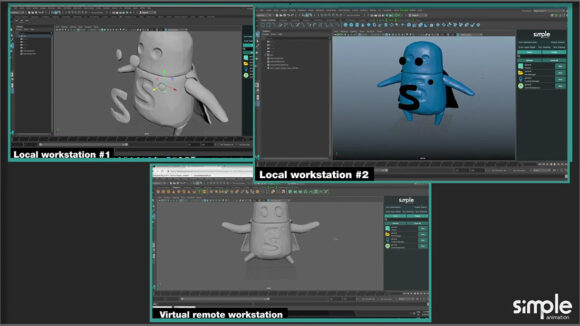

In 2019, Discover The Revolution Of Cloud-Based Production With Simple Animation
Since the beginning of time, the evolution of technology has changed our habits, routines and environment continually, and it is no different in the world of animation, where technology has played a key role in the development of the art form. We are currently on the cusp of another transformative moment in the development of animation tech: cloud technology.
Cloud-based production models represent a pivotal development in the history of the art form, much akin to other key developments the history of animation technology, such as:
1917: When Max Fleischer received a patent on rotoscoping, a technique that allowed animators to trace over live-action motion picture footage frame-by-frame to produce realistic action:

1932: Walt Disney created the first three-strip color cartoon, Flowers and Trees, using the Technicolor process, which simultaneously exposed three strips of black-and-white film, each of which recorded a different color of the spectrum.
1933: Ub Iwerks created the first multiplane camera using movable layers of flat artwork before a horizontal camera. The camera allowed depth of field and unprecedented three-dimensional effects in 2d animation, and it was soon employed by Disney in his first feature film, Snow White and the Seven Dwarfs.

1962: Ivan Sutherland’s Sketchpad was the first computer program that allowed the direct manipulation of graphic objects, a pioneering example of human-computer interaction and the predecessor of today’s cgi software.
1972: Ed Catmull and Fred Parke created A Computer Animated Hand, one of the earliest rendered three-dimensional objects that was entirely computer-generated.
2019: At present, we are immersed in another great evolution, which promises to change our habits, routines, and environment. That evolution is cloud technology.
Although cloud technology is present in our day-to-day lives (Spotify, Gmail, Netflix, etc.), it is only beginning to make a big impact in animation, adapting to the demands and needs of today’s animation industry. Cloudy technology in animation recognizes that the vast majority of animation projects are global, with multiple actors involved in different parts of the production process. The collaborative aspect of animation gains importance with each passing year, while information traffic grows and the security of that information becomes more fundamental than ever.
In these early stages of cloud-based animation production, there are numerous competing services emerging, and the concept of global, cloud-based, virtual studio platforms vary widely in each of these services.
Simple Animation has placed its key emphasis on infrastructure, while incorporating a powerful configurable pipeline within its service. Simple understands that studios that have already made investments in infrastructure with defined pipelines, and that they can’t easily change their on-premises model for another model that is completely in the cloud.
Therefore, Simple has come up with something in between; that is to say that studios can continue using their traditional infrastructure, but have the option of extending to the cloud during peak production periods. This alternative is ultimately that of an on-premises hybrid/cloud model.
Here is how Simple’s Hybrid Model Works
Simple’s hybrid cloud services allows studios to implement their own pipeline using the company’s configurable pipeline manager tool (API) within their local workstations and synchronized into Simple’s cloud.
In this way, the studio continues using their local infrastructure, benefiting from a configurable pipeline with the possibility to expand transparently into the cloud.
Simple’s hybrid cloud computing enables studios to deploy an on-premises private cloud to host sensitive or critical workloads and use a third-party public cloud provider to host less-critical resources. It is also particularly valuable for dynamic or highly changeable workloads. For example, during crunch times around project delivery, it is possible to use cloud bursting to access additional computing resources as computing demands spike.
Cloud technology will undoubtedly continue to evolve. And so too will studio production pipelines to best take advantages of cloud technology’s many benefits. Some of these benefits include: reduction of costs, time-saving, scalability, flexibility, security, unlimited storage, global coverage, pay-as-you-go models, and integrated render farms.
Like all technological revolutions, the cloud will take some time to fully establish itself within the animation industry’s framework, but the change is coming.
And with Simple Animation, it can simply happen.

.png)